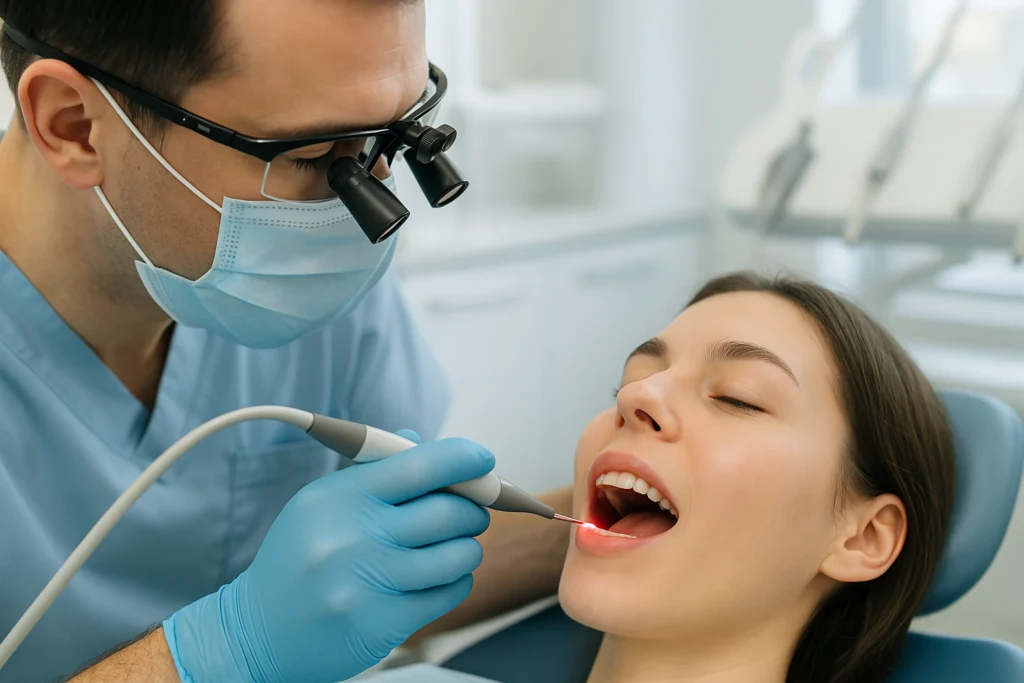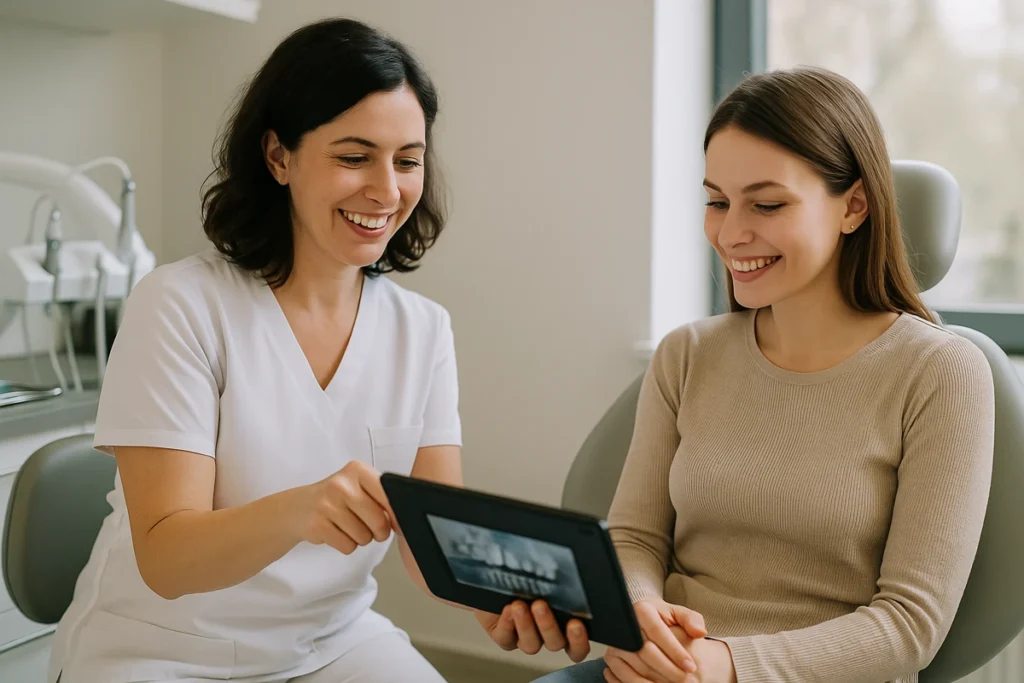That familiar sound of the dental drill can make you tense. It’s not the most pleasant experience, yet traditional dentistry has been the trusted standard for decades.
Now, laser technology has become another viable option. Each method has distinct advantages depending on your needs.
So which one’s right for you? We’ll help you to figure this out.
We’ll compare both approaches honestly, showing you the real pros and cons so you can decide what works best.
We’ve spent over 20 years in dental care at GPIAG, so we’ll share what we’ve actually seen work (and what hasn’t).
Let’s get started.
What Is Traditional Dentistry?

Traditional dentistry is the standard approach that uses drills, scalpels, and other physical tools to fix dental problems. It’s what most people think of when they picture a dental visit. These methods have been around for decades and can handle just about any dental issue you throw at them.
Why It’s Still the Go-To Method
Traditional dentistry is easy to find. Nearly every dental practice offers it, so you won’t be hunting around or driving hours for an appointment.
Cost is another plus. Insurance companies know this, so coverage is simple with no surprises. Cost is another plus. Insurance usually covers these procedures without any fuss, and you’re often looking at lower upfront costs compared to newer options.
Traditional tools also handle complicated work reliably. Large fillings, crown preparations, intricate procedures between teeth: these are where drills shine (pun intended). Think of it like a carpenter using tools they’ve mastered over the years, not a gadget they just unboxed. That familiarity lets dentists tackle complications confidently when they arise.
The Drawbacks You Should Know About
Nobody enjoys the sound of the dental drill. That high-pitched whirring makes even calm patients tense up. Vibration and pressure add to the discomfort, especially during longer treatments.
These methods are also more invasive. You’ll often need more anaesthesia to stay comfortable. Recovery takes longer, particularly for gum or soft tissue work. Drills generate heat and friction that some patients notice even when numbed.
Drawing from our experience in dental care, these sensory factors often make people delay dental visits. It’s not the pain itself but the discomfort around it.
Pro tip: If the drill makes you uneasy, ask about sedation options or bring noise-cancelling headphones. Remember that traditional methods still outperform lasers for certain procedures. When your dentist recommends the drill, there’s usually solid clinical reasoning behind it.
Laser Dentistry: Precision Without the Drill

Dental lasers use concentrated beams of light to treat teeth and gums with precision. More practices now offer them as an alternative to traditional tools.
It sounds high-tech, and it is, but the concept is simple. Different wavelengths target different parts of your mouth. Some are gentle enough for soft tissue like gums, while others are powerful enough to work on tooth enamel. Your dentist adjusts based on what needs to be done.
What Makes Laser Dentistry Different
Lasers address many comfort issues that traditional dentistry can create. Here’s how laser treatments improve the patient experience:
Skip the Anaesthesia
Many laser procedures involve less pain. In some cases, you won’t need anaesthesia at all. If you dislike needles or that lingering numb feeling afterwards, this matters.
Based on our firsthand experience, this is one of the biggest reasons patients who’ve avoided dental care finally come in for treatment.
Minimal Bleeding and Swelling
Lasers seal blood vessels and nerve endings as they work, so there’s less bleeding and swelling during and after treatment. That also helps you heal faster. You’re often back to normal within a day or two.
Protects Healthy Tissue
Lasers can target the exact problem area without touching the surrounding healthy tissue. There’s no vibration, no drill noise, and no heat buildup that you’d notice.
For the 25% of UK adults who delay dental care because of anxiety, removing these sensory triggers can be life-changing. The difference in comfort level is remarkable.
Pro Tip: If you’re someone who’s avoided the dentist for years because of anxiety, ask specifically about laser options for your first visit back. Starting with a less invasive experience can help rebuild your confidence.
Built-In Sterilisation
As lasers work, they sterilise the treatment area, reducing infection risk. It’s like getting a mini cleaning while your treatment happens.
We’ve seen this work well for soft tissue procedures like gum reshaping, treating periodontal disease, teeth whitening, and some cavity preparations.
When Lasers Aren’t Enough
Still, lasers can’t handle everything. They excel at specific procedures but have clear boundaries.
- Limited use for certain procedures. Large cavities between teeth, crown preparation, or removing old fillings often require drills, which handle those tasks more efficiently.
- Cost runs higher. Laser treatments typically cost more than traditional ones, and not every insurance plan covers them fully.
- Availability varies by location. While laser dentistry is growing, not every practice has the equipment. In regional areas, you may need to travel further for treatment.
- Not a full replacement. Even experienced laser dentists keep traditional tools on hand for when lasers can’t complete the job.
Your Smile, Your Choice

There’s no one-size-fits-all answer here. The right method depends on your situation, your budget, and what you’re comfortable with. Here’s what to think about when you’re deciding:
- The procedure: What needs to be done? Some treatments work better with lasers, others require traditional tools. Ask your dentist which method they’d recommend and why.
- Comfort preferences: Does drill noise make you anxious? Are you sensitive to vibration and pressure? Lasers might suit you better. But if cost is the main concern and you can handle the sensory experience, traditional methods could be smarter.
- Availability and budget: Is laser dentistry offered near you? What’s the cost difference? Does insurance cover it? These practical questions matter as much as clinical ones.
- Recovery needs: How quickly do you need to bounce back? Lasers typically offer faster healing, which matters if you have work or personal commitments.
Over 20 years in dental care, we’ve learned one thing: the “best” method is the one that works for your life, not the one that sounds coolest on paper.
If you’re still not sure what’s right for you, talk to your dentist. A good one won’t push you toward the fanciest option. They’ll tell you what actually makes sense.
Want to learn more about your options? Visit the GPIAG website to learn more about how we can help you make better decisions about your oral health.


